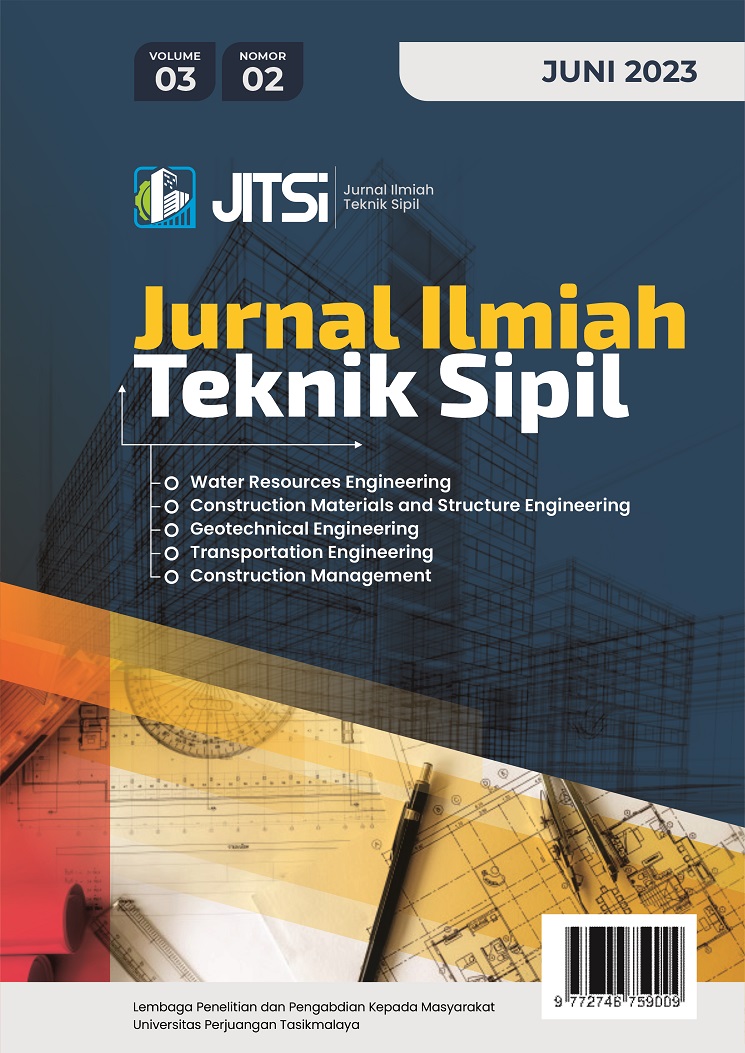STUDI ANALISIS DEBIT BANJIR DENGAN MENGGUNAKAN METODE HIDROGRAF SATUAN NAKAYASU PADA SALURAN IRIGASI WILAYAH BOBOJONG KECAMATAN INDIHIANG
DOI:
https://doi.org/10.36423/jitsi.v3i2.1259Keywords:
Synthetic Unit Hydrograph Nakayasu, Discharge, Water LevelAbstract
Abstrack – The heavy rain that occurred in Bobojong Village caused the Citanduy tributary irrigation canal to overflow by around 10-50 cm around the canal, as a result dozens of houses and roads were submerged. Other factors such as the loss of water catchment areas caused by changes in land use that affect runoff water. From the problems above, the purpose of this study is to determine the flood discharge at the 20-year return period and the water level that occurs in the irrigation canals in the Bobojong area. The method used in this study uses the Nakayasu HSS method. Based on the results of analysis on the Cimulu Building Irrigation Channel (BCMU) 39 using the Nakayasu HSS method, the 20 year return period is 34.3 m3/s. The result of the flood water level for the 20 year return period is 3042.905 m. If you look at the results, it shows that the water level is unrealistic compared to the water level in the field, where the results of field interviews show that the water level reaches 1.9 m from the bottom of the canal. so that it can be concluded that there are several possibilities that occur there, namely: The area of the catchment area does not match the reality in the field or the research catchment area is larger than the actual catchment area, for the Nakayasu HSS method it is more widely used for large size watersheds and is more appropriate for flood discharge analysis return period design or return period ≥ 100 years (Eka et all., 2020)
Keywords — Synthetic Unit Hydrograph Nakayasu, Discharge, Water Level
Abstrak – Hujan deras yang terjadi di Kampung Bobojong mengakibatkan saluran irigasi anak sungai Citanduy meluap kira-kira 10-50 cm di sekitar saluran, akibatnya puluhan rumah maupun jalan terendam. Faktor lain seperti hilangnya daerah resapan air yang diakibatkan oleh perubahan tataguna lahan sehingga mempengaruhi pada air limpasan. Dari permasalahan diatas dimana tujuan dari penelitian ini adalah untuk mengetahui debit banjir pada kala ulang 20 tahun serta tinggi muka air yang terjadi di saluran irigasi wilayah Bobojong. Metode yang digunakan dalam penelitian ini menggunakan metode HSS Nakayasu Berdasarkan hasil analisis pada Saluran Irigasi Bangunan Cimulu (BCMU) 39 dengan menggunakana metode HSS Nakayasu pada kala ulang 20 tahun adalah 34.3 m3/s. Hasil dari tinggi muka air banjir kala ulang 20 tahun adalah 3042.905 m. Bila dilihat hasil menunjukan bahwa tinggi muka air tidak realistis dari tinggi muka air di lapangan, dimana hasil wawancara di lapang tinggi muka air mencapai 1.9 m dari dasar saluran. sehingga dapat disimpulkan ada beberapa kemungkinan yang terjadi dianatanya yaitu : Luas Daerah Tangkapan Air tidak sesuai dengan realitas di lapangan atau DTA penelitian lebih besar dari DTA sesungguhnya, untuk metode HSS Nakayasu lebih banyak digunakan untuk DAS dengan ukuran besar dan lebih tepat digunakan untuk analisis debit banjir rancangan kala ulang atau periode ulang ≥ 100 tahun (Eka et all., 2020)
Kata Kunci — Hidrograf Satuan Sintetik Nakayasu, Debit, Tinggi Muka Air.
References
Badan Informasi Geospasial (2018). Peta Rupa Bumi: Online (https://www.big.go.id/sejarah/, Diakses 10 Oktober 2021)
Badan Informasi Geospasial (2014). DEM SRTM 30m Provinsi Jawa Barat (https://www.indonesia-geospasial.com/2020/01/download-dem-srtm-30-meterse-indonesia.html, Di akses 2 Oktober 2021)
Eka, Y., Nggarang, P., Pattiraja, A. H., & Henong, S. B. (2020). ANALISA PERBANDINGAN PENENTUAN
DEBIT RENCANA MENGGUNAKAN METODE NAKAYASU DAN SIMULASI APLIKASI HEC-HMS DI DAS LOWO REA. Jurnal Teknik Sipil, 1(1).
Febriana Ideawati, L., Limantara, L. M., & Andawayanti, U. (n.d.). ANALISIS PERUBAHAN BILANGAN KURVA ALIRAN PERMUKAAN (RUNOFF CURVE NUMBER) TERHADAP DEBIT BANJIR DI DAS LESTI.
Hasanudin, A., & Hasanudin, A. (2020). PENURUNAN PUNCAK HYDROGRAF ALIRAN PERMUKAAN DENGAN TATA KELOLA LIMPASAN AIR HUJAN (RUNOFF) MELALUI OPTIMALKAN PROGRAM ANTAR KEMENTERIAN/LEMBAGA (WHOLE OF GOVERNMENT) PADA DAS HULU. Jurnal Teknovasi : Jurnal Teknik Dan Inovasi, 7(2), 36–46.
https://www.ejurnal.plm.ac.id/index.php/Teknovasi/article/view/457
Nganro, S., Trisutomo, S., Barkey, R. A., Ali, M., & Nurdin, N. (2020). Model Spasial Level Dasar Bangunan Kota Tepian Air (Studi Kasus: Kota Makassar). TATALOKA, 22(3), 418–427. https://doi.org/10.14710/tataloka.22.3.418-427.
Noor Annisa Ramadan, A., Nurmayadi, D., Sadili, A., Rizaldy Solihin, R., & Sumardi, Z. (2020). Studi Penentuan Nilai Curve Number DAS Pataruman berdasarkan Satuan Peta Tanah Indonesia. In Media Komunikasi TeknikSipil (Vol. 26, Issue 2).
http://repository.unpar.ac.id/handle/123456789/6605.
Suadnya, D. P., Sumarauw, J. S. F., & Mananoma, T. (2017). ANALISIS DEBIT BANJIR DAN TINGGI MUKA AIR BANJIR SUNGAI SARIO DI TITIK KAWASAN CITRALAND. Jurnal Sipil Statik, 5, 143–150.
Downloads
Published
How to Cite
Issue
Section
License
Copyright (c) 2023 Anggi Saputra, Agi Rivi Hendardi

This work is licensed under a Creative Commons Attribution-ShareAlike 4.0 International License.




